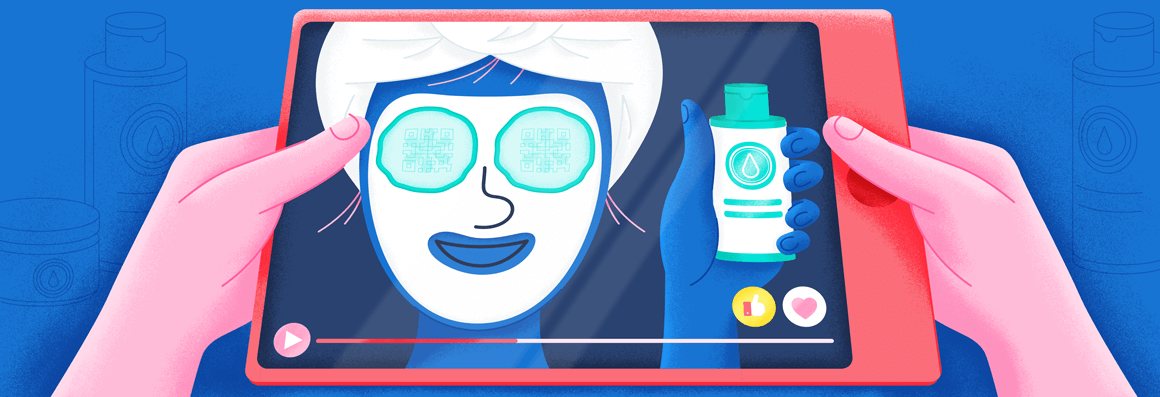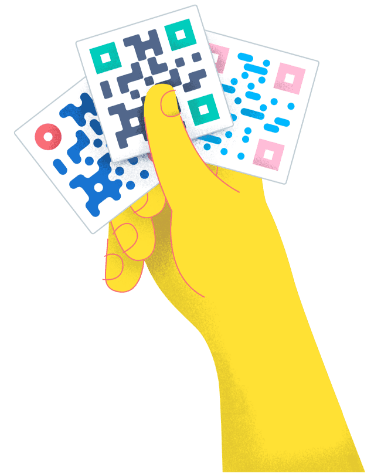- Best Practices ●
- COVID-19 ●
- Industry Trends ●
- Partners ●
- Product ●
The Curator’s Guide To Using QR Codes in Museums and Art Galleries
A museum or art gallery experience is like an escape to a world ruled by nothing but creativity. Every color and texture speaks to the limitless nature of human imagination, and every artifact tells the story of past civilizations and all they achieved. It’s no wonder gallery and museum visits are top pastime activities for people worldwide.
Want to enhance the visitor experience even further? Integrate Quick Response (QR) Codes into your gallery or museum to offer more information about exhibits, provide immersive experiences, give virtual tours, and enhance accessibility. Thanks to their versatility, the use cases for QR Codes are limitless!
Ready to leverage this innovative technology? Read on as we explore the best ways to use QR Codes in museums and galleries.
Are QR Codes worth it for museums and art galleries?
QR Codes have an interesting history that, like the exhibits in museums and art galleries, shows that there are no bounds to what’s achievable. While they were initially developed for auto parts tracking, they found numerous uses across virtually all industries, including arts and entertainment.
Museums like the Mattress Factory and Brooklyn Museum were quick to adopt the technology over a decade ago to provide additional resources on art and history pieces.
However, QR Codes weren’t very popular then because many people didn’t have smartphones. And those who did needed to download third-party scanner apps to read the codes.
Apple and Android eliminated this barrier when they created built-in smartphone QR Code readers. The result was a massive surge in QR Code use in tourism, hospitality, and numerous other industries.
Now, many museums and art galleries have adopted QR Code technology to elevate their visitor experiences and refine their offerings. QR Codes help these institutions:
- Offer visitors deeper insights into the stories behind their exhibits and art pieces without taking up too much wall space.
- Provide interactive experiences by linking to various multimedia content, including videos, audio, and even augmented reality (AR) experiences.
- See which areas and exhibits people find most interesting by analyzing data on the number of scans.
6 Examples of museums and art galleries that use QR Codes
QR Codes have become invaluable to many museums and art galleries. Some use them to provide detailed information on art exhibitions, others to offer access to audio guides, and others to market their latest installations.
Here, we’ll take a look at real-world establishments that are leveraging QR Codes to show you the power and versatility of these seemingly simple innovations.
Note: The examples below were found during the online research for this article.
1. The National Museum of Scotland
The National Museum of Scotland offers QR Code audio tours to improve visitor engagement with various exhibits and boost satisfaction. All guests need to do is pick the trail or tour they want to take and scan the designated QR Code to dive into the museum’s collections using pre-recorded guides.
The guides tell the stories behind the different collections, facilitating a better understanding of each exhibit than visitors would get from printed descriptions. Using QR Codes in this way helps improve the visitor experience by offering deeper insights into each collection.
Like The National Museum of Scotland, you can link QR Codes to audio exhibit descriptions to promote learning. Or, if you want to gamify your experience and add a bit more excitement to museum visits, you can create QR Code scavenger hunts to help visitors discover hidden gems in your collections.
You simply need to create audio files with clues, link them to your QR Codes, and place the codes at different locations so that each one leads to the next clue and hidden gem.
2. Museum of London Docklands
Unfortunately, people living with disabilities don’t always get to fully enjoy museums and art galleries because of inaccessibility to certain spaces and information. The Museum of London Docklands is changing that.
Not only is the museum making its areas more accessible, but it’s also leveraging QR Codes to ensure people with disabilities can access detailed information about each exhibit.
This museum has linked QR Codes to 13 videos in British Sign Language, allowing visitors with hearing disabilities to enjoy self-guided tours and learn about key collections.
QR Codes are ideal for accessibility because they can link to a wide range of content, allowing you to meet the needs of different groups. For example, to help people with sight difficulties enjoy the museum or gallery experience, you can link QR Codes to audio recordings.
3. Meow Wolf
Meow Wolf’s Convergence Station is revolutionizing art by using QR Codes as the basis for a work of art that allows visitors to access various soundscapes. The gallery has created an interactive wall of QR Codes (the Exo-Terrarium), which link to different videos, webpages, and articles exploring spirituality, genetic engineering, and alchemy.
It’s an incredible sight and a unique approach to using QR Codes in the art space. The QR Codes don’t merely direct scanners to detailed information about the Exo-Terrarium room—they are the art itself.
4. Depot Boijmans Van Beuningen
Depot Boijmans Van Beuningen provides an immersive experience for visitors by using QR Codes to tell the stories behind its art pieces. Visitors scan the codes using the museum’s app to access interesting tidbits about showcased artwork.
These codes link to various content, including text, videos, and audio. They even link to questions and quizzes that challenge visitors to look deeper into the artwork, promoting a greater appreciation for the pieces.
This strategy highlights the functionality of QR Codes in art. They improve guest experiences because they can provide more context and allow greater creativity than standard art gallery signage.
Through QR Codes, you can let visitors know when art pieces were created and why, the materials used, and who created them. You can even test their understanding, all without taking up too much space.
5. Smithsonian National Museum of Natural History
The Smithsonian National Museum used QR Codes to improve its internal database. The museum’s first digitization project was the bee collection. The handlers tasked with the process removed the museum’s bees from storage and assigned QR Codes to each one, making it easy for staff to access bee information whenever necessary.
Beyond helping with recordkeeping, this strategy has facilitated greater accessibility to the museum’s insect collection. Now, researchers don’t have to travel to D.C. to use the Smithsonian’s data—as of February 2020, 2.8 million items from the museum’s collection went open access.
6. Blue Moose Art Gallery
Want to elevate your marketing efforts? QR Codes can help! The proof is in Blue Moose Art Gallery’s QR Code marketing campaign.
The gallery uses QR Codes to promote its products by linking them to images of its art and displaying them across its marketing channels. It also uses QR Codes to sell products by linking them to its website and displaying them on product tags. This allows interested parties to initiate purchases with a single QR Code scan.
Further, the art gallery uses QR Codes to promote its social media pages by linking them to its Facebook, Instagram, and X (formerly Twitter) pages and displaying them in its gallery and website. This way, all art enthusiasts need to do is scan the codes to follow and engage with the art connoisseurs on their preferred platforms.
How to start using QR Codes in your museum or gallery
Ready to follow in the footsteps of these museums and art galleries? Read on for tips on how to get started with QR Codes.
Start small
It’s tempting to want to go big on your first QR Code project. But this isn’t advisable, as you may make mistakes that could impact its performance. For example, if you don’t first understand their functionality and best use cases, you may end up using the wrong types of QR Codes.
Before you commit to a large campaign, start small. First, find a user-friendly QR Code platform with a wide range of features, like QR Code Generator PRO.
Next, research basic QR Code best practices, like the minimum QR Code size and where to place QR Codes to maximize engagement. You should also learn about common QR Code scanning problems and solutions so you know how to fix any issues you run into.
Then, identify the best areas to incorporate QR Codes and plan accordingly. For instance, if you want your codes to direct visitors to detailed information on specific museum exhibits or art pieces, prepare the content you want to show beforehand. When that’s done, you can create QR Codes and link them to the digital content.
If you want to test the effectiveness of QR Codes before committing yourself, start with basic options and observe how they perform. For example, you could incorporate a Feedback QR Code into a banner or signage near the exit or add a QR Code to business cards that direct visitors to social media.
If scan data shows an interest in these QR Codes, you can move on to larger or more permanent projects, like QR Code engravings near key collections.
Leverage different types of QR Codes
There are numerous types of QR Codes you can choose from to improve visitor experiences. So don’t just confine yourself to just one or two. Some examples of QR Codes you can leverage include:
- Video QR Codes to share video tours or recordings that provide more information about exhibits.
- MP3 QR Codes for audio tours.
- SMS QR Codes to provide seamless exhibit updates and enhance communication with visitors.
- Coupon QR Codes to offer discounts on admission.
- Social Media QR Codes to grow your online following or link to a visitor feedback platform.
Finally, be sure to choose Dynamic QR Codes rather than Static QR Codes so you can determine the effectiveness of your QR Code projects. Dynamic QR Codes allow you to track and monitor your scan data to determine what kind of content resonates best with visitors.
Get creative
The beauty of QR Codes is that they’re versatile and can meet a wide range of needs, from enhancing accessibility to supporting marketing campaigns. So feel free to lean on the examples discussed in this post for inspiration on how to leverage these innovative solutions.
But don’t restrict yourself only to what’s already done—feel free to get creative. For example, you can use QR Code Generator’s SMS QR Code not only to send text message updates but also to create a queue system for very desirable or busy exhibits.
Work with relevant stakeholders, like museum guides, artists, and marketing teams, to brainstorm creative ways QR Codes could benefit your museum or gallery.
Take the museum experience to the next level with QR Codes
QR Codes for museums and art galleries can increase engagement with exhibits and art pieces, enhance learning experiences, boost accessibility for people with disabilities, and more. With QR Codes, your creativity is your only limitation.
QR Code Generator PRO empowers museums and art galleries with reliable, easy-to-create QR Codes that can enhance the visitor experience. The platform provides numerous QR Code types to fit virtually any situation, and you can even customize the codes with your logo, colors, and other brand elements.
Get started with QR Code Generator PRO and immerse your visitors in an interactive experience.





